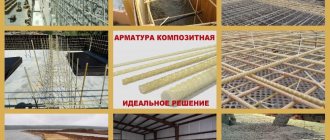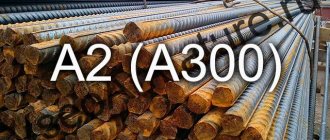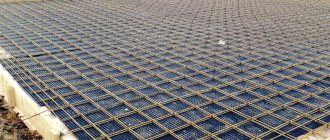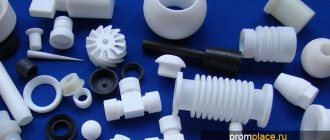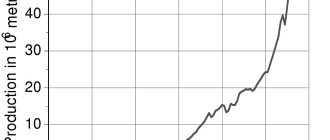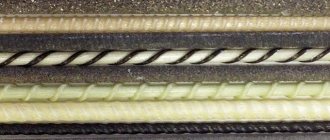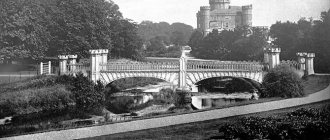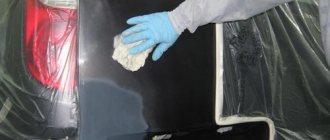Metal reinforcement is considered a reliable option for forming the “skeleton” of monolithic concrete. And today its importance and necessity in construction is not in doubt, although a new type of reinforcement has appeared on the market and is steadily progressing - composite or fiberglass (FRP). The material can be called “new” quite conditionally; it came to the market 50 years ago. For Russia, fiberglass was irrelevant until recently; we have enough resources to produce our own metal at a reasonable price for construction.
At the same time, fiberglass reinforcement has caught up and surpassed metal in a number of properties, and conclusions about the strength and durability of the material can be drawn from global experience in operating spas.
Structure of composite reinforcement
A building material is made from fiberglass fiber impregnated with a polymer binder in the form of relief rods of a given size - fiberglass reinforcement. Material structure:
- Inner rod. Serves to provide basic functional characteristics. Fiberglass fibers are used in production. They are placed in the structure of the rods in parallel or in the form of braided weaving, then filled with polymer resin.
- External covering. It is performed by winding composite fibers onto an internal rod or by spraying a fine abrasive onto it.
Production and requirements for fiberglass reinforcement
The production of spas is a rather complex technological process that requires special equipment and raw materials. Aluminum borosilicate glass and an oil-containing polymer binder composition are used as feedstock.
All the main elements of the SPA production line are shown in the following figure:
Layout diagram of a line for the production of fiberglass reinforcement. Expert's point of view
Dmitry Kholodok
Technical director of repair and construction
Ask a Question
“The production of fiberglass reinforcement is regulated by the Interstate Standard GOST 31938-2012 “Composite polymer reinforcement for the reinforcement of concrete structures. General technical conditions."
Standard sizes and parameters
The diameter of the produced spa varies in the range of 4 – 18 mm. Products are produced in the form of measuring rods or in coils.
The total length of the reinforcement in the coil depends on the technological equipment used in its manufacture. Spas with a diameter of 12 mm or more are offered to the consumer exclusively in the form of rods.
The main parameters affecting the scope of application include the weight of one meter and the diameter of the composite rod.
The winding pitch can be considered an additional characteristic, but today almost all manufacturers produce reinforcement with a pitch of 15 mm.
Which reinforcement is better, metal or fiberglass?
One of the main arguments given in favor of fiberglass reinforcement when compared with metal reinforcement is its lower price. However, if you look at the price tags of metal warehouses, you will see that this is not so. The cost of metal is on average 20-25% lower than the composite.
The reason for the confusion is that plastic sellers take into account the so-called “equivalent” diameter. The logic here is this: non-metallic reinforcement is tensile stronger than construction steel. Therefore, a polymer rod with a smaller diameter will withstand the same load as thicker steel reinforcement. Based on this, the conclusion is drawn: less plastic is needed to reinforce a structure than metal. This is where the “lower” price comes from.
For a reasoned comparison of a composite with metal, a regulatory document is needed. Today such guidance already exists. This is Appendix “L” to the order of the Ministry of Construction of Russia No. 493/pr dated 07/08. 2016
In paragraph L.2.3. obscure for ordinary developers, but very interesting for professionals, contains two reduction factors for all types of composite reinforcement.
For example, consider the most common fiberglass (FRP):
- Under continuous load, its tensile strength should be multiplied by 0.3. That is, instead of 800 MPa we get 240 MPa (800x0.3=240).
- If the structure operates outdoors, then the result obtained must be multiplied by another 0.7 (240 MPa x 0.7 = 168 MPa).
Table with reduction coefficient for composite reinforcement
Table with coefficients taking into account operating conditions
Further, as required by the standard, the resulting 168 MPa must be divided by a safety factor (safety factor) equal to 1.5. As a result, we get 112 MPa.
Now you can correctly compare the strength of plastic reinforcement with metal. For example, let's take construction steel grade A500. Its ultimate tensile strength, taking into account the safety factor, is 378 MPa. For the fiberglass composite, we obtained only 112 MPa.
Our small study is clearly illustrated by a table of real, and not theoretical, equal-strength replacement of steel reinforcement with composite reinforcement. It can be used when choosing and purchasing.
Having looked at this table, it is easy to notice that for plastic to be an equivalent replacement for metal, not less, but more metal is required. Only the most expensive carbon fiber material (CF) is superior to steel of equal diameter.
Areas of application
Due to the demand for fiberglass reinforcement in construction, manufacturers began to offer products not only in the traditional version - coils and rods. Fiberglass reinforcing meshes and ready-made reinforced frames have appeared on the market in various designs in shape and dimensional parameters.
Composite reinforcement is used in a number of construction works and the manufacture of building structures:
- Reinforcement of structures made of monolithic concrete: walls, wells, coatings, foundations.
- Strengthening masonry made of piece wall materials - brick, stone, as well as porous and lightweight blocks of all types.
- In the construction of road surfaces and strengthening of embankments.
- Construction of buildings using permanent formwork technologies.
- Providing flexible connections of load-bearing, facing, reinforcing layers in the construction of multi-layer walls and other structures.
- Manufacturing of power transmission line supports and railway sleepers.
- Use as dowels for fastening thermal insulation of buildings.
- Installation of utilities, sewerage, drainage.
- Creation of reclamation systems.
- Composite products have gained particular popularity among summer residents and owners of personal plots. SPA is used on the arcs of greenhouses, to create decorative and economic fencing, and to support fruit trees.
CONNECTION WITH CEMENT
Rice. 3. Use of fiberglass composite reinforcement
When using lightweight structural concrete, it is possible to achieve improved thermal and acoustic characteristics, reduce the weight of structures, and increase the fire resistance of the structure.
When calculating and designing reinforced concrete structures using fiberglass composite reinforcement, the principles are similar to those used during the design of reinforced concrete elements, in cases where the combination of the work of concrete and reinforcement is considered the most important element. Based on the research of Zinovkin, A.A., Masalov A.V. – the connection of fiberglass composite reinforcement with concrete is ensured due to the adhesion of cement stone with an epoxy coating, and not due to the mechanical engagement of the coils, inside the concrete matrix, as with profiled metal reinforcement
Reinforcement can be of several types: internal, external and combined, which is a combination of the first two.
Figure 4. The first concrete pedestrian bridge in Europe with fiber-reinforced concrete polymers.
Internal reinforcement can be made in the form of discrete, dispersed and mixed. Discrete reinforcement is the use of fiberglass reinforcement in the form of individual rods, flat and spatial frames, and meshes. There can also be combinations, for example, individual rods, meshes, etc. Dispersed reinforcement is an additive to the concrete mixture during mixing of chopped fibers (fibers), which are randomly placed in the concrete. Using special methods, it is possible to achieve a directional arrangement of fibers. With dispersed reinforcement, concrete is usually called fiber-reinforced concrete.
External reinforcement is especially important if structures are used in an environment that is aggressive towards concrete. In this case, the external sheet reinforcement will simultaneously have three functions: strength, protection, and act as formwork during concreting.
External reinforcement can also be divided into continuous and discrete. With continuous reinforcement, it is a sheet structure that completely covers the surface of the concrete; with discrete reinforcement, it is in the form of mesh-type elements or individual strips.
Concrete structures in fiberglass shells can be produced in several ways. For example, after manufacturing a concrete element, it is possible to dry it and then enclose it in a fiberglass shell, carrying out a multi-layer winding with glass material (fiberglass or glass tape) with layer-by-layer impregnation with resin. After polarization of the binder, the winding will take the form of a continuous fiberglass shell. And the entire element will become a pipe-concrete structure. In the second method, a fiberglass shell is first made and then filled with concrete mixture.
Depending on the type of polymer binder and fiber used in production, the resistance of fiberglass to aggressive environments may also change. During internal reinforcement, it is necessary to take into account not only the relationship of fiberglass reinforcement to the external environment, but also the nature of the interaction with concrete in the liquid state. Hardening concrete has an alkaline reaction, which can cause destruction of aluminoborosilicate fiber. For such cases, it is necessary to protect the fibers with layers of resin or use fibers with a different composition. In cases where unwetted concrete structures are used, there is virtually no corrosion of fiberglass. In the presence of wetted structures, the level of alkalinity in the concrete environment can be reduced through the use of cement with active mineral additives.
Ribbed and smooth rods
The ribbed profile of the products is necessary to improve adhesion to the concrete mixture. Sometimes, for the same purpose, the surface of the reinforcement is sprinkled with sand during the hardening process.
Fiberglass rods with a smooth surface cannot have proper adhesion to concrete, which is why they are less in demand as reinforcement for concrete work.
But the price of smooth rods is much lower, so it makes sense to use them as auxiliary products with minimal load when assembling a frame for reinforcement.
Physical properties and materials used in the production of reinforcing products
The main characteristics were obtained after a series of scientific research and the introduction of the latest developments. Some properties allow it to be used for reinforcement in residential and industrial construction:
- light weight of products - steel reinforcement is an order of magnitude heavier (9 times);
- is not subject to destruction from corrosion, acids, alkalis. According to this indicator, metal fittings are inferior by 10 points;
- low level of thermal conductivity. When arranging foundations and floor slabs, the possibility of thermal insulation failure due to cold bridges is reduced to 0.
- light and flexible - this quality simplifies its delivery and work;
- does not conduct electricity, is not susceptible to stray currents;
- Due to its plasticity, it can take any shape; there is no need to use welding or cutting machines.
Thanks to these characteristics, reinforcing the foundation with fiberglass reinforcement becomes justified both in production and economic terms. Much in this matter is decided by the material used for the production of ASP. The industry produces composite non-metallic reinforcement from several types of modern plastics. They have a base made of the following materials:
- Fiberglass.
- Carbon fiber.
- Basalt-plastic.
- Made from aramid.
- Material created on the basis of glass-reinforced polyethylene terephthalate.
The price of some materials does not allow their use in mass quantities. For this reason, 2 types of materials are most popular. These are fiberglass and basalt plastic products. The main trunk is woven from many strands of material. They are connected using thermoactive synthetic resins.
To securely connect the rod, either sand coating is applied, or the trunk is wrapped around several turns running in a spiral. When using fiberglass reinforcement, one should take into account its property of slight stretching in a concrete product. In this case, there will be very little contact with the concrete and separation of the coils or abrasive coating will occur.
Products made of basalt plastic do not have a reliable connection with concrete. The best fixation is provided by coils made of carbon fiber, applied to the fiberglass main barrel. In this case, the load is evenly distributed over the entire part and the rod is normally fixed to the concrete mass.
Advantages of composite reinforcement
Thanks to the combination of non-metallic fibers and a binder composite composition, fiberglass reinforcement has acquired additional qualities and properties that are actively used in practice:
- low specific weight, which reduces transportation costs and facilitates installation;
- no welding operations required;
- tensile strength, almost twice that of metal;
- chemical resistance;
- low level of thermal conductivity combined with a wide operating temperature range;
- high dielectric constant.
The advantages of the material itself are complemented by the features of the technological process:
- all core threads are equally stressed, which enhances the strength of the spa;
- the thread flow at the twisting stage is cleared of all kinds of contaminants, which ensures optimal consumption of components during production and helps reduce the final cost of products;
- To increase chemical resistance and enhance adhesion to concrete, the reinforcement is coated with a layer of vinyl ester resin.
Mesh made of fiberglass reinforcement
The reinforcing mesh is a single-layer flat frame. It consists of rods located perpendicular to each other, connected at the joints. Their main function is to increase the strength and resistance to deformation of monolithic and prefabricated structures.
Advantages of composite masonry mesh:
- strength;
- ease of installation;
- light weight;
- ease of transportation;
- durability;
- corrosion resistance;
- high adhesion strength;
- dielectric properties;
- environmental friendliness;
- resistance to deformation.
Composite mesh is used in the following cases:
- reinforcement of brickwork;
- performing screeding and leveling floors;
- pouring foundation slabs, basement walls;
- strengthening wall panels and ceilings;
- concreting roads;
- reinforcement of concrete products, gypsum sculptures, decorative elements of buildings;
- strengthening the walls of hydraulic structures;
- construction of bridges, strengthening of embankments.
The use of a composite mesh reduces the formation of transverse cracks on construction sites by 2 times. This type of reinforcing products is gradually replacing rolled metal products with similar purposes.
Recommendations for choosing products
Criteria for selecting a spa for construction work:
- compliance of the product diameter with the declared values;
- quality of winding of the outer layer;
- Availability of quality certificates and material test reports.
If after a visual inspection it turns out that the color of the fittings is darker than that declared by the manufacturer, then it is not recommended to purchase such products. Darkening of the spa means a violation of the temperature conditions during manufacturing, the product is considered burnt, and its technical characteristics do not correspond to the declared ones.
Properties of the new material
This type of reinforcement is superior to metal in many properties:
- Strength. Because of this, when knitting a mesh, you can increase the mesh size or use rods of a smaller diameter with the same strength. Both options significantly facilitate the finished structure.
- Immune to water, including sea water. It is no coincidence that composite materials are used in port construction and when laying sewerage and reclamation networks.
- Resistant to acids and alkalis. Thanks to this, structures become more durable, and there is no internal stress due to corrosive swelling.
- Low thermal conductivity. Composite reinforcement improves the performance characteristics of housing, since it is not a conductor of cold inside concrete.
- Lightweight and transportable, which provides significant savings in costs and man-hours.
Designers and construction market participants have appreciated the advantages of composite reinforcement. This progressive material is more economical, and with increasing diameter the difference in favor of the polymer analogue increases.
Another plus is the lack of cracking, since non-metallic elements have the same rate of expansion under heat as concrete. Polymer reinforcement does not create radio interference and does not change its properties under the influence of magnetic fields.
Comparison of the characteristics of steel and fiberglass reinforcement
You should not compare and evaluate steel and composite reinforcement, dividing it into “good” or “bad” based on a set of characteristics. There are precise definitions of when fiberglass reinforcement should not be used, and when it may be the best solution.
As a rule, the justification for any choice is the technical characteristics of fiberglass reinforcement and its metal competitor.
Comparison of these types of fittings is inevitable, since they have similar parameters and areas of application, which means they can be mutually replaced if certain conditions are met.
How is mating carried out?
The key to creating a reliable reinforcing frame is the competent connection of the elements that make it up. The methodology for carrying out the work depends on the specifics of the object and the technical specifications of the construction project. There are several connection methods.
- Clips. The rods are fixed using a special bar with presses. This method is the simplest, fastest and most convenient. The components are fastened at an angle of 90°. The size of the clips must correspond to the diameter of the reinforcement used. This connection ensures strength and rigidity of the structure.
- Plastic clamps. This is the second easiest method of connecting spas. The clamps are tightened at the intersection of the rods. For greater rigidity, two clamps are cross-connected at once. Using pliers, remove the excess part of the fastener. It is not recommended to leave protruding ends as they can create voids. Moisture entering them will negatively affect the strength and durability of the structure.
- Metal wire. In this case, a simple or semi-automatic hook is used. The method is suitable for bars of various diameters.
To connect the SPA, there are special fasteners that are secured with latches. There are special automatic tying guns that fasten rods to staples or wire.
Knitting SPA when reinforcing screeds
The design of concrete floors, thick screeds and slab foundations is carried out using plastic racks. Each of them is an independent reinforcing element. The rods are secured at right angles with crimp latches along the edges of the post. For such a connection, it is not necessary to cut large pieces of reinforcement and knit between horizontal layers.
For thin screeds, it is allowed to use clips for composite reinforcement having a C-shape. With their help, it is easy to obtain the required gap between the base and the reinforcing mesh.
Knitting fiberglass reinforcement for strip foundations
If there are intersections, corners, or lateral junctions, the frame lines are connected using U-shaped parts. They allow you to connect external reinforcement to a perpendicular mesh. The corners are formed by attaching L-shaped rods to the main frame with two wire ties. The resulting overlap must be at least 300 mm. Finished reinforcing mesh is connected by straight sections. All intersections are knitted inside the formwork at the installation site. The distance from its borders must be at least 25 mm.
It is not recommended to heat reinforcing bars to create a bend yourself. This can lead to loss of strength characteristics of the material. To avoid problems, ready-made rods of the required shape are ordered.
Strapping is an important process to obtain a strong frame structure. Compliance with technology serves as a guarantee of quality.
Flaws
The popularity of fiberglass reinforcement is justified by a number of undoubted advantages, but the material also has disadvantages that can cancel out all the advantages.
Low modulus of elasticity
This indicator means that composite products should not be used to reinforce monolithic floors or sections thereof. If it is absolutely necessary to use SPA, it is necessary to carry out careful technical calculations.
Low thermal stability
Fiberglass reinforcement is a self-extinguishing material that cannot spread fire in concrete structures. But at high temperatures, spa products sharply lose their functional strength characteristics, which limits the scope of application of composite reinforcement.
Loss of strength
Fiberglass reinforcement reduces or loses its strength characteristics over time (polymer organic bonds are destroyed - the so-called “aging” process of organics). The process is accelerated when the reinforcement is exposed to alkaline environments. To avoid this drawback, composite products with the addition of rare earth metals should be used.
Taking into account all the listed, even unique advantages of fiberglass reinforcement rods, their use is allowed only in conditions and structures where the material will not experience destructive loads and impacts.
Pros and cons of composite fiberglass reinforcement
The reason that after its appearance on the market SPA became quite in demand were the positive qualities of this material, which include:
- light weight;
- resistance to oxidation and other types of corrosion;
- low thermal conductivity;
- long service life;
- is a dielectric (does not conduct electric current);
- Possibility of use without the use of welding equipment.
Disadvantages are also present, but they are much smaller, these are:
- relatively low thermal stability;
- low elasticity values.
Using SPA in the manufacture of foundations
Related article:
Tying reinforcement under a strip foundation is a reliable way to create a rigid metal frame for a reinforced concrete structure. We will tell you how to carry out this work correctly and without extra costs in this detailed material.
Nuances and features
As with any relatively new building material, there are many conflicting opinions about SPA in professional and amateur circles. Let's try to understand the authenticity and validity of some judgments.
About SPA bending
The need to bend reinforcement often arises during construction, directly on site. But fiberglass rods cannot be bent efficiently directly at the installation site - this is what distinguishes it from metal. Builders often consider this a disadvantage of the spa, but not critical. There are two acceptable solutions:
- Bent elements are ordered from the manufacturer in advance if there is a reinforcement design or at least an understanding of the need for bending.
- It is possible to use mixed reinforcement. In this case, composite rods are connected to corner elements made of metal reinforcement.
About the regulatory framework for the use of spas
Opponents of fiberglass reinforcement in construction argue that its use on construction sites is illegal, since there are no regulations and standards for its use. This is just a half-truth. In fact, the use of composite rods is permitted by GOST; no one has the right to prohibit the implementation of a project with expertly verified load calculations. But there is a problem - the lack of programs and approved structural calculation models for the use of composite reinforcement. But for low-rise construction there is no need for such standards and programs. It is possible to build a small house or cottage using a spa, for which you can use approximate standards and advice from knowledgeable professionals.
About the color of composite rods
The initial, standard color of the SPA is light yellowish. As a rarer option, black, if the source material is basalt. Color is intended to make composite rods attractive; this is more of a marketing move, it is not caused by necessity. But there has been some kind of information leak on the market: supposedly coloring additives in the composite improve its characteristics.
Therefore, let’s put the point straight away: color does not in any way affect the quality of fiberglass reinforcement. Perhaps color schemes play some role when using spas for household needs in dachas and gardens.
Advantages and disadvantages of use
Reviews from builders allow us to recognize the following main advantages:
- the low weight of the products not only makes it easier for workers, but also makes the structures quite light. Therefore, it is used for cellular concrete and other materials that reduce the weight of the structure while maintaining a high level of reliability and strength;
- metal, capable of transmitting cold through cold bridges. The use of fiberglass reinforcement eliminates this possibility; this advantage is especially important in monolithic construction of buildings;
- material consumption is reduced when packaging it in coils. The lashes are produced in lengths of 12 meters, which allows for more economical cutting. This point is especially important in private construction, when every ruble spent is scrupulously calculated;
- increases the economic component, the possibility of linking without overlaps and the use of welding work;
- composite reinforcement can serve for a long time and not lose its properties, but metal reinforcement laid in a concrete slab also does not decompose;
- dielectric properties guarantee safe living in the building, but this advantage is controversial. Concrete itself is a dielectric;
- a high level of resistance to chemicals is important when performing foundation work at low temperatures. At this time, various additives are added to the concrete;
- Does not interfere with the passage of radio waves. This quality is especially important in monolithic construction; metal fittings interfere with the normal operation of mobile communications and the passage of radio signals. The use of composite reinforcement can reduce the level of radio interference in the building.
These products also have disadvantages. A specialist using this material can easily name them:
- Reinforcing fiberglass (FRP) exceeds the cost of steel reinforcement. But this disadvantage is easily offset by the possibility of using thinner reinforcement for a similar type of work;
- is subject to deformation and destruction at high temperatures, but the likelihood of such an impact inside concrete is unrealistic;
- if fiberglass reinforcement is used for a foundation with many turns, it is not possible to bend the parts for bending, but the problem is easily solved. It is enough to take a piece of steel rod, bend it at the desired angle and tie it to the main lash;
- one of the main disadvantages is the low elasticity when the rod breaks. In this case, fiberglass reinforcement is inferior to steel, but it works better in tension. Due to its low resistance to fracture, its use in capital construction is somewhat limited;
- when using it in the foundation and pouring concrete from a mixer, you need to be extremely careful. Glass reinforcement cannot be placed in a rigid frame and under high pressure its integrity may be damaged. Composite mesh is the best solution to the problem.
How to knit fiberglass reinforcement, but easier than metal. This does not require the use of different hooks. It is tied together with self-tightening plastic clamps. The operation is simple and requires a minimum of knowledge and tools.
Having considered the advantages and disadvantages, it is impossible to unequivocally answer the question of which is better - light plastic or rigid steel. Only construction engineers can do this.
